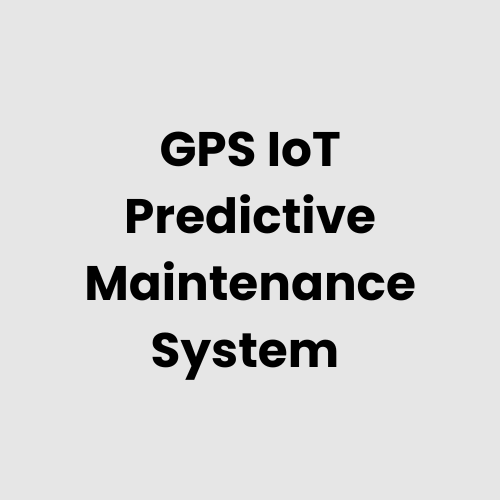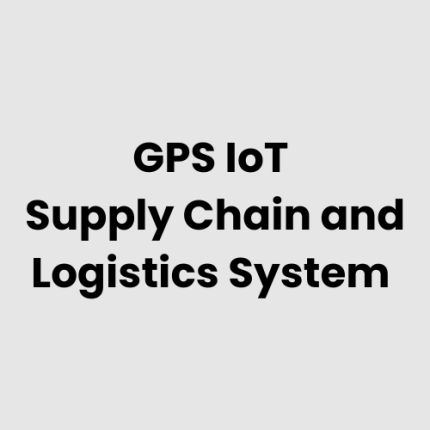GPS IoT Predictive Maintenance System
Explore GAOTek’s GPS IoT Enabled Predictive Maintenance IoT System for advanced monitoring, real-time data, and predictive maintenance applications.
Description
Technical Architecture of GPS IoT Enabled Predictive Maintenance IoT System
The GPS IoT Enabled Predictive Maintenance IoT System is designed to optimize the maintenance lifecycle of critical assets by leveraging real-time GPS data, sensors, and machine learning algorithms. The system architecture comprises various interconnected components:
- Sensors and IoT Devices: These include vibration sensors, temperature sensors, and other IoT devices installed on machinery to collect real-time data on asset health.
- GPS Module: Provides accurate positioning data to assess location-based maintenance needs.
- Data Aggregation Layer: Collects and aggregates data from sensors and GPS modules in real-time for further analysis.
- Edge Computing: Local computing systems process the data to perform initial analysis and anomaly detection before transmission.
- Cloud Computing: The processed data is sent to the cloud for deep analysis using machine learning models, predictive analytics, and visualization tools.
- Visualization Layer: Provides real-time dashboards, predictive maintenance alerts, and analytics for technicians and managers.
- Alert System: Uses predefined thresholds and anomaly detection algorithms to notify maintenance personnel of potential issues requiring attention.
List of Hardware for GPS IoT Enabled Predictive Maintenance IoT System
- IoT Sensors: Vibration sensors, temperature sensors, humidity sensors, pressure sensors, and proximity sensors.
- GPS Module: High-accuracy GPS trackers for asset location monitoring.
- Edge Computing Devices: Local processing units to perform data analysis at the device level.
- Communication Devices: IoT gateways and communication modules (Wi-Fi, Zigbee, LoRaWAN, or 5G) for data transmission.
- Server Hardware: For cloud-based or on premise data storage and processing.
- Power Supply Units: To ensure continuous operation of devices in the field.
- Display Devices: For real-time monitoring and visual data representation.
Physical Placement Considerations of the Hardware
- Sensor Placement: Sensors must be strategically placed on machinery or assets to capture critical data points such as vibrations, temperature, and pressure. They should be positioned in areas most susceptible to failure or wear and tear.
- GPS Modules: Installed on moving or stationary assets, such as vehicles or heavy machinery, to track their locations.
- Edge Devices: These are typically placed near the equipment they monitor, ensuring low-latency data processing.
- Communication Devices: Should be positioned in areas with optimal network coverage for seamless data transmission.
- Power Management: Devices must be positioned to ensure easy access to power sources or equipped with battery backup for continuous operation in remote locations.
Hardware Architecture of GPS IoT Enabled Predictive Maintenance IoT System
The hardware architecture of the GPS IoT Enabled Predictive Maintenance IoT System is composed of several layers:
- Data Collection Layer: Comprising IoT sensors (vibration, temperature, etc.) attached to the machinery or assets, this layer collects real-time data.
- Communication Layer: Ensures seamless data transmission from sensors to local edge devices or gateways.
- Edge Computing Layer: Performs initial data aggregation and pre-processing on-site to detect any immediate issues before sending the data to the cloud.
- Cloud Layer: Centralized data processing, predictive analytics, and long-term data storage. The cloud platform runs machine learning algorithms to predict potential failures and generate maintenance schedules.
- User Interface Layer: Provides users with real-time dashboards and alerts. Maintenance personnel can access this layer for system monitoring, troubleshooting, and data-driven decision-making.
Deployment Considerations of GPS IoT Enabled Predictive Maintenance IoT System
- Network Availability: Ensure reliable network infrastructure for continuous data transmission, especially in remote or industrial environments.
- System Integration: The system should integrate seamlessly with existing enterprise software and maintenance management systems.
- Scalability: The solution should scale easily across different assets, machinery, or operational sites.
- Security: Security protocols, including encryption and authentication, must be implemented to protect sensitive maintenance data.
- Data Storage: Consideration for whether data is stored on a local server, cloud platform, or a hybrid solution based on privacy requirements.
List of Relevant Industry Standards and Regulations
- ISO 55000: Asset management standards
- ISO 9001: Quality management systems
- IEC 61508: Functional safety of electrical, electronic, and programmable electronic safety-related systems
- ISO 26262: Automotive functional safety
- NIST SP 800-53: Security and privacy controls
- OSHA regulations: Occupational health and safety standards
- GDPR: General Data Protection Regulation (for data privacy)
- IEEE 802.15.4: Wireless communication standards
Local Server Version of GPS IoT Enabled Predictive Maintenance IoT System
For organizations requiring localized processing and data storage, a local server version of the GPS IoT Enabled Predictive Maintenance IoT System can be deployed. This version processes and stores data onsite, without relying on cloud infrastructure. It offers advantages in environments where data privacy, security, or internet access may be a concern.
Key features:
- Local Data Processing: Edge computing enables the system to process data onsite, minimizing latency.
- Private Network: Data remains within the organization’s network, enhancing security.
- Scalability: Local servers can be scaled according to the size of the operation, with the ability to integrate additional machines or assets.
Cloud Integration and Data Management
Cloud integration is a critical component of the GPS IoT Enabled Predictive Maintenance IoT System, enabling organizations to leverage the vast computational power and storage capabilities of the cloud.
- Data Collection: IoT sensors continuously collect data, which is transmitted to the cloud in real-time.
- Predictive Analytics: Machine learning algorithms run in the cloud to analyze the incoming data and predict future equipment failures based on historical trends.
- Real-Time Monitoring: Dashboards and alert systems, hosted in the cloud, provide users with real-time status updates on equipment health and maintenance needs.
- Long-Term Data Storage: The cloud allows for scalable and secure storage of maintenance data, enabling long-term analysis and decision-making.
- Interoperability: The cloud system integrates seamlessly with enterprise resource planning (ERP) and maintenance management systems (CMMS) to streamline maintenance scheduling and resource allocation.
GAO Tek Inc. is a trusted provider of GPS IoT solutions, offering businesses cutting-edge technologies to monitor and maintain equipment, ensuring maximum uptime, cost savings, and operational efficiency. Our GPS IoT Enabled Predictive Maintenance IoT System is designed to streamline your maintenance processes, leveraging data-driven insights to predict issues before they occur. Whether you’re working with local servers or utilizing cloud platforms, GAO Tek’s support and expertise provide the foundation for better asset management across industries.
GAO Case Studies of GPS IoT Enabled Predictive Maintenance IoT System
USA Case Studies
- New York City,NY – Industrial Manufacturing Facility
In New York City, a major industrial manufacturing facility implemented a GPS IoT Enabled Predictive Maintenance IoT System to monitor the health of their production machinery. The system collects real-time data from sensors placed on critical equipment and analyses this data to predict maintenance needs, reducing downtime and increasing productivity.
- San Francisco, CA – Transportation Fleet Management
A transportation fleet operating in San Francisco adopted the GPS IoT Enabled Predictive Maintenance IoT System to track vehicle performance and maintenance requirements. By using GPS and sensor data, the system provides alerts for vehicle diagnostics, ensuring timely maintenance and reducing unexpected breakdowns, thus improving fleet efficiency.
- Chicago, IL – HVAC Systems in Commercial Buildings
A commercial property in Chicago leveraged the predictive maintenance capabilities of GPS IoT technology for their HVAC systems. By monitoring temperature fluctuations and component health, the system detects early signs of failure and schedules proactive maintenance, reducing energy consumption and improving system reliability.
- Houston, TX – Oil and Gas Industry Equipment
In Houston, the GPS IoT Enabled Predictive Maintenance IoT System was implemented for monitoring critical oil and gas exploration equipment. Using real-time sensor data, the system analyses machinery wear and tear, allowing for more accurate maintenance scheduling and preventing costly unplanned downtime in hazardous environments.
- Miami, FL – Data Centres
A data centre in Miami utilized the predictive maintenance system to monitor the performance of its cooling and power equipment. By integrating GPS and IoT sensors, the system provides real-time diagnostics and maintenance alerts, helping prevent equipment failures and ensuring uninterrupted service for clients.
- Los Angeles, CA – Manufacturing Plant Equipment
A manufacturing plant in Los Angeles incorporated the GPS IoT Enabled Predictive Maintenance IoT System to track the condition of heavy machinery and robotics. The system uses sensor data to predict malfunctions and optimize maintenance schedules, thus enhancing productivity and reducing operational disruptions.
- Seattle, WA – Aircraft Maintenance
An aviation company in Seattle applied GPS IoT technology to track the health of its aircraft fleet. The predictive maintenance system gathers real-time data on engine performance and other critical components, predicting when maintenance is needed to prevent costly repairs and ensure flight safety.
- Phoenix, AZ – Utility Grid Infrastructure
A utility company in Phoenix employed a GPS IoT Enabled Predictive Maintenance IoT System to monitor power grid infrastructure. The system collects data from sensors on transformers and circuit breakers, providing early warnings for potential issues and helping optimize the timing of grid repairs, minimizing service interruptions.
- Boston, MA – Commercial HVAC Systems
In Boston, a commercial HVAC service provider implemented predictive maintenance technology to monitor the performance of HVAC systems across multiple commercial buildings. The system predicts failures and schedules maintenance to reduce energy costs and enhance the efficiency of these systems.
- Dallas, TX – Wind Turbine Monitoring
A renewable energy company in Dallas adopted GPS IoT-enabled predictive maintenance for wind turbines. The system provides real-time monitoring of turbine conditions, detecting signs of wear and failure, and ensuring that maintenance is performed proactively, leading to improved energy production efficiency.
- Denver, CO – Mining Equipment
In Denver, a mining operation utilized the GPS IoT Enabled Predictive Maintenance IoT System to monitor mining equipment like drill rigs and haul trucks. With predictive maintenance alerts, the system helped prevent unplanned equipment failures, reducing downtime and ensuring smoother mining operations.
- Washington, DC – Government Facility Equipment
A government facility in Washington, DC deployed GPS IoT Enabled Predictive Maintenance IoT System for monitoring building infrastructure, including HVAC, elevators, and fire suppression systems. The system alerts maintenance personnel when critical components need attention, helping avoid costly repairs and extending the lifespan of the equipment.
- Atlanta, GA – Warehouse Equipment
A logistics company in Atlanta installed the GPS IoT Enabled Predictive Maintenance IoT System to monitor the performance of warehouse equipment, such as conveyor belts and automated pickers. The system anticipates maintenance requirements based on real-time sensor data, improving operational efficiency and reducing machine failures.
- Minneapolis, MN – Agricultural Equipment
An agricultural operation in Minneapolis implemented a predictive maintenance system for their fleet of tractors and harvesters. The GPS-enabled IoT system collects real-time performance data to predict when repairs are needed, optimizing the maintenance process and reducing costly breakdowns during critical harvest seasons.
- Portland, OR – Smart Building Infrastructure
A smart building in Portland integrated the GPS IoT Enabled Predictive Maintenance IoT System to monitor and optimize its critical infrastructure, including lighting, HVAC, and security systems. The system collects data from sensors and GPS modules to predict potential issues and schedule maintenance proactively, improving building efficiency and reducing operational costs.
Canada Case Studies
- Toronto, ON – Industrial Manufacturing Facility
In Toronto, Canada, an industrial facility adopted a GPS IoT Enabled Predictive Maintenance IoT System to improve equipment reliability. The system monitors machinery using IoT sensors and GPS data, predicting maintenance requirements to avoid unexpected failures and reduce operational downtime in the manufacturing process.
- Vancouver, BC – Municipal Water Treatment Plant
A municipal water treatment plant in Vancouver, Canada, implemented a GPS IoT Enabled Predictive Maintenance IoT System to monitor pumps, filtration systems, and other critical infrastructure. Real-time sensor data is used to predict maintenance needs, ensuring efficient operations and extending the life of essential water treatment equipment.
Navigation Menu for GPS IoT
- GPS IoT Trackers/Devices
- GPS IoT Tracking Accessories
- GPS IoT Tracking Resources
- GPS IoT – Cloud, Server, PC & Mobile Systems
Navigation Menu for IoT
- LORAWAN
- Wi-Fi HaLow
- Z-WAVE
- BLE & RFID
- NB-IOT
- CELLULAR IOT
- GPS IOT
- IOT SENSORS
- EDGE COMPUTING
- IOT SYSTEMS
Our products are in stock and can be shipped anywhere in the continental U.S. or Canada from our local warehouse. For any further information, please fill out this form or email us.
We are actively looking for partners who are like us located in the U.S. and Canada. For more information on partnering with GAO, please visit Partner with GAO Tek Inc.It lists various ways to partner with GAO, such as OEM Partnerships, Technology Integration, Distribution and Reselling Opportunities, Presenting at the Leading Event Tek Summit, Joint R&D Projects, Training and Consulting Services, Industry-Specific Collaborations, Research and Academic Partnerships.



